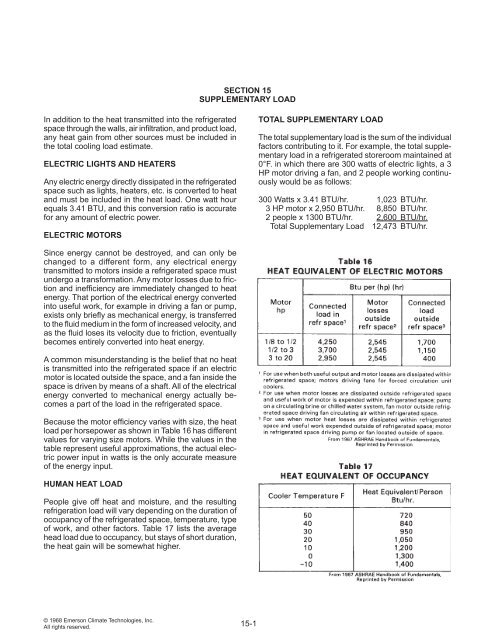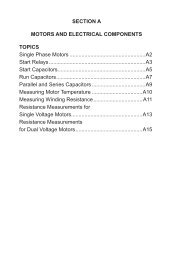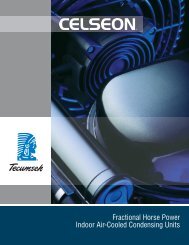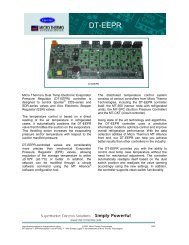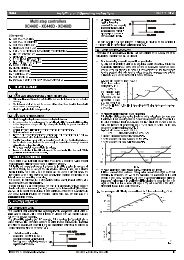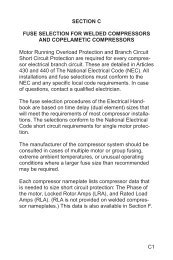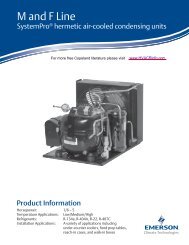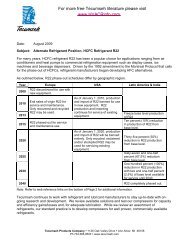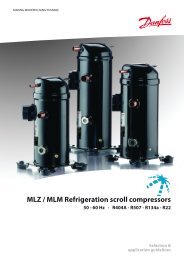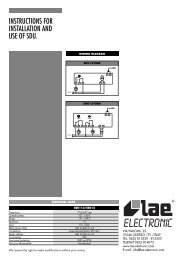Section 15SUPPLEMENTARY LOADIn addition to the heat transmitted into the refrigeratedspace through the walls, air infiltration, <strong>and</strong> product load,any heat gain from other sources must be included inthe total cooling load estimate.ELECTRIC LIGHTS AND HEATERSAny electric energy directly dissipated in the refrigeratedspace such as lights, heaters, etc. is converted to heat<strong>and</strong> must be included in the heat load. One watt hourequals 3.41 BTU, <strong>and</strong> this conversion ratio is accuratefor any amount of electric power.ELECTRIC MOTORSTOTAL SUPPLEMENTARY LOAD<strong>The</strong> total supplementary load is the sum of the individualfactors contributing to it. For example, the total supplementaryload in a refrigerated storeroom maintained at0°F. in which there are 300 watts of electric lights, a 3HP motor driving a fan, <strong>and</strong> 2 people working continuouslywould be as follows:300 Watts x 3.41 BTU/hr. 1,023 BTU/hr.3 HP motor x 2,950 BTU/hr. 8,850 BTU/hr.2 people x 1300 BTU/hr. 2,600 BTU/hr.Total Supplementary <strong>Load</strong> 12,473 BTU/hr.Since energy cannot be destroyed, <strong>and</strong> can only bechanged to a different form, any electrical energytransmitted to motors inside a refrigerated space mustundergo a transformation. Any motor losses due to friction<strong>and</strong> inefficiency are immediately changed to heatenergy. That portion of the electrical energy convertedinto useful work, for example in driving a fan or pump,exists only briefly as mechanical energy, is transferredto the fluid medium in the form of increased velocity, <strong>and</strong>as the fluid loses its velocity due to friction, eventuallybecomes entirely converted into heat energy.A common misunderst<strong>and</strong>ing is the belief that no heatis transmitted into the refrigerated space if an electricmotor is located outside the space, <strong>and</strong> a fan inside thespace is driven by means of a shaft. All of the electricalenergy converted to mechanical energy actually becomesa part of the load in the refrigerated space.Because the motor efficiency varies with size, the heatload per horsepower as shown in Table 16 has differentvalues for varying size motors. While the values in thetable represent useful approximations, the actual electricpower input in watts is the only accurate measureof the energy input.HUMAN HEAT LOADPeople give off heat <strong>and</strong> moisture, <strong>and</strong> the resultingrefrigeration load will vary depending on the duration ofoccupancy of the refrigerated space, temperature, typeof work, <strong>and</strong> other factors. Table 17 lists the averagehead load due to occupancy, but stays of short duration,the heat gain will be somewhat higher.© 1968 Emerson Climate Technologies, Inc.All rights reserved.15-1
Section 16EQUIPMENT SELECTIONOnce the refrigeration load is determined, together withthe required evaporating temperature <strong>and</strong> the expectedcondensing temperature, a compressor can be intelligentlyselected for a given application.For refrigerated fixtures or prefabricated coolers <strong>and</strong>cold storage boxes to be produced in quantity, theload is normally determined by test. If the load mustbe estimated, the expected load should be calculatedby determining the heat gain due to each of the factorscontributing to the total load. Many short methods ofestimating are commonly used for small refrigeratedwalk-in storage boxes with varying degrees of accuracy.A great deal of judgment must be used in the applicationof any method.HOURLY LOAD<strong>Refrigeration</strong> equipment is designed to function continuously,<strong>and</strong> normally the compressor operating time is determinedby the requirements of the defrost system. <strong>The</strong>load is calculated on a 24 hour basis, <strong>and</strong> the requiredhourly compressor capacity is determined by dividingthe 24 hour load by the desired hours of compressoroperation during the 24 hour period. A reasonable safetyfactor must be provided to enable the unit to recoverrapidly after a temperature rise, <strong>and</strong> to allow for loadingheavier than the original estimate.When the refrigerant evaporating temperature will not bebelow 30°F., frost will not accumulate on the evaporator,<strong>and</strong> no defrost period is necessary. It is general practiceto choose the compressor for such applications on thebasis of 18 to 20 hour operation.For applications with storage temperatures of 35°F.or higher, <strong>and</strong> refrigerant temperatures low enough tocause frosting, it is common practice to defrost by stoppingthe compressor <strong>and</strong> allowing the return air to meltthe ice from the coil. Compressors for such applicationsshould be selected for 16 to 18 hour operation.On low temperature applications, some positive meansof defrost must be provided. With normal defrost periods,18 hour compressor operation is usually acceptable,although some systems are designed for continuousoperation except during the defrost period.An additional 5% to 10% safety factor is often added toload calculations as a conservative measure to be surethe equipment will not be undersized. If data concerningthe refrigeration load is very uncertain, this may be desirable,but in general the fact that the compressor is sizedon the basis of 16 to 18 hour operation in itself providesa sizable safety factor. <strong>The</strong> load should be calculatedon the basis of the peak dem<strong>and</strong> at design conditions,<strong>and</strong> normally the design conditions are selected on thebasis that they will occur no more that 1% of the hoursduring the summer months. If the load calculations aremade reasonably accurately, <strong>and</strong> the equipment sizedproperly, an additional safety factor may actually resultin the equipment being oversized during light load conditions,<strong>and</strong> can result in operating difficulties.SAMPLE LOAD CALCULATION<strong>The</strong> most accurate means of estimating a refrigerationload is by considering each factor separately. <strong>The</strong> followingexample will illustrate a typical selection procedure,although the load has been chosen to demonstrate thecalculations required <strong>and</strong> does not represent a normalloading.Walk-in cooler with 4 inches of glass fiber insulation,located in the shade.Outside Dimensions, Height 8 ft., Width 10 ft.,Length 40 ft., inside volume 3,000 cu. ft.Floor area (outside dimensions) 400 sq. ft. on insulatedslab in contact with ground.Ambient temperature 100°F., 50% relative humidityGround temperature 55°F.Refrigerator temperature 40°F.1/2 HP fan motor running continuouslyTwo 100 watt lights, in use 12 hours per day.Occupancy, 2 men for 2 hours per day.In storage:500 pounds of bacon at 50°F.1000 pounds of string beansEntering product:500 pounds of bacon at 50°F.15,000 pounds of beer at 80°F.To be reduced to storage temperaturein 24 hours.Heavy door usage.16-1© 1968 Emerson Climate Technologies, Inc.All rights reserved.


